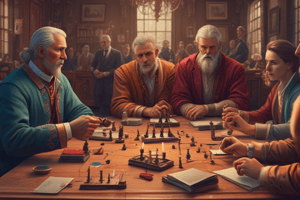Podcast
Questions and Answers
Which of the following accurately describes the theme of Conflict and Resolution within the chapter?
Which of the following accurately describes the theme of Conflict and Resolution within the chapter?
- It exclusively addresses resolutions that occur without conflict.
- It highlights key conflicts and their eventual settlements. (correct)
- It focuses solely on continuous peace-related events.
- It examines disputes without discussing their resolutions.
What aspect does Model B primarily address according to the chapter’s framework?
What aspect does Model B primarily address according to the chapter’s framework?
- The historical accuracy of the events.
- The significance of power dynamics in societal change. (correct)
- The role of cultural shifts in conflict.
- The effects of individual actions on major events.
Which figure is noted for their contributions to the chapter's exploration of power structures?
Which figure is noted for their contributions to the chapter's exploration of power structures?
- Figure 1 who primarily discussed economic theories.
- Figure 1 and Figure 3, with no mention of Figure 2.
- Figure 3 who played a crucial role in historical events related to power. (correct)
- Figure 2 who focused on artistic developments.
What was the overarching consequence of Event 2 as described in the chapter?
What was the overarching consequence of Event 2 as described in the chapter?
How did socio-economic conditions affect the political landscape discussed in the chapter?
How did socio-economic conditions affect the political landscape discussed in the chapter?
Study Notes
Key Themes
- Conflict and Resolution: Examination of key disputes and their resolutions within the chapter's framework.
- Change and Continuity: Focus on what changed over time versus what remained consistent.
- Power Structures: The influence of various power entities and their dynamics.
- Innovation and Progress: The impact of innovations on society and culture.
Important Figures
- [Figure 1]: Brief description of their contributions and relevance to the chapter.
- [Figure 2]: Key achievements and their impact on the chapter's main topics.
- [Figure 3]: Overview of their role in historical events discussed.
Theories and Models
- Theory A: Explanation of the theory and its application within the context of the chapter.
- Model B: Discussion of the model’s purpose and significance.
- Framework C: How it helps interpret various events or themes in the chapter.
Major Events
- Event 1: Key details (what, when, where, impact).
- Event 2: Overview of the event’s significance and consequences.
- Event 3: Discussion of how this event links to larger themes of the chapter.
Historical Context
- Socio-economic Conditions: The state of society and economy leading up to the events discussed.
- Cultural Influences: How culture shaped the themes and events covered in the chapter.
- Political Landscape: Overview of the political environment during the time period relevant to the chapter’s content.
Conflict and Resolution
- Key disputes analyzed within the chapter's context.
- Methods and outcomes of conflict resolution explored.
Change and Continuity
- Identifiable changes over the examined period.
- Aspects that remained consistent throughout the period.
Power Structures
- Influence and dynamics of various power entities.
- Analysis of power relationships and their impact.
Innovation and Progress
- Significant innovations discussed.
- Society's and culture's responses to these innovations.
Important Figures: [Figure 1]
- Contributions of [Figure 1].
- Relevance to the chapter's central themes.
Important Figures: [Figure 2]
- [Figure 2]'s key achievements.
- Impact of their actions on the chapter's topics.
Important Figures: [Figure 3]
- Role of [Figure 3] in historical events.
- Link to the chapter's narrative.
Theories and Models: Theory A
- Explanation of Theory A.
- Application of Theory A to the chapter's events.
Theories and Models: Model B
- Purpose and significance of Model B.
- Relevance to the interpretation of the chapter's content.
Theories and Models: Framework C
- Use of Framework C for interpreting events.
- How Framework C clarifies chapter themes.
Major Events: Event 1
- Details of Event 1 (what, when, where, and impact).
- Significance of Event 1 within the broader context.
Major Events: Event 2
- Overview of Event 2 and its consequences.
- Event 2's contribution to the chapter's main arguments.
Major Events: Event 3
- Details of Event 3.
- Connection between Event 3 and overarching themes.
Historical Context: Socio-economic Conditions
- State of society and economy during the period.
- Influence of socio-economic factors on the events discussed.
Historical Context: Cultural Influences
- Cultural factors shaping the chapter's events and themes.
- Impact of cultural context on the historical narrative.
Historical Context: Political Landscape
- Political environment during the period.
- Political factors influencing the events and themes examined.
Studying That Suits You
Use AI to generate personalized quizzes and flashcards to suit your learning preferences.
Description
Explore the key themes of conflict and resolution, change and continuity, and the dynamics of power structures within this chapter. This quiz delves into major events, important figures, and relevant theories that have shaped historical narratives. Test your understanding and interpretation of these essential concepts.




